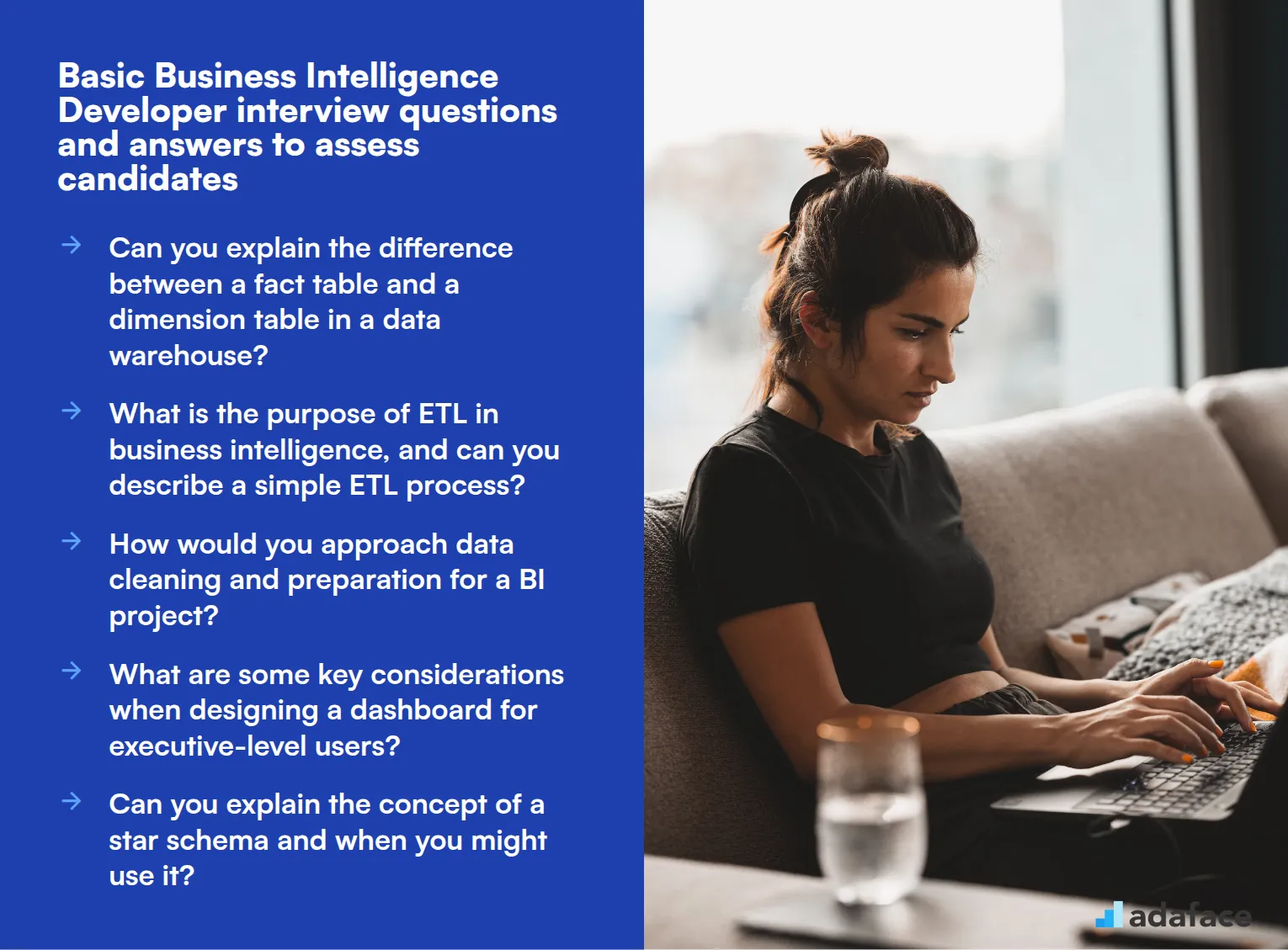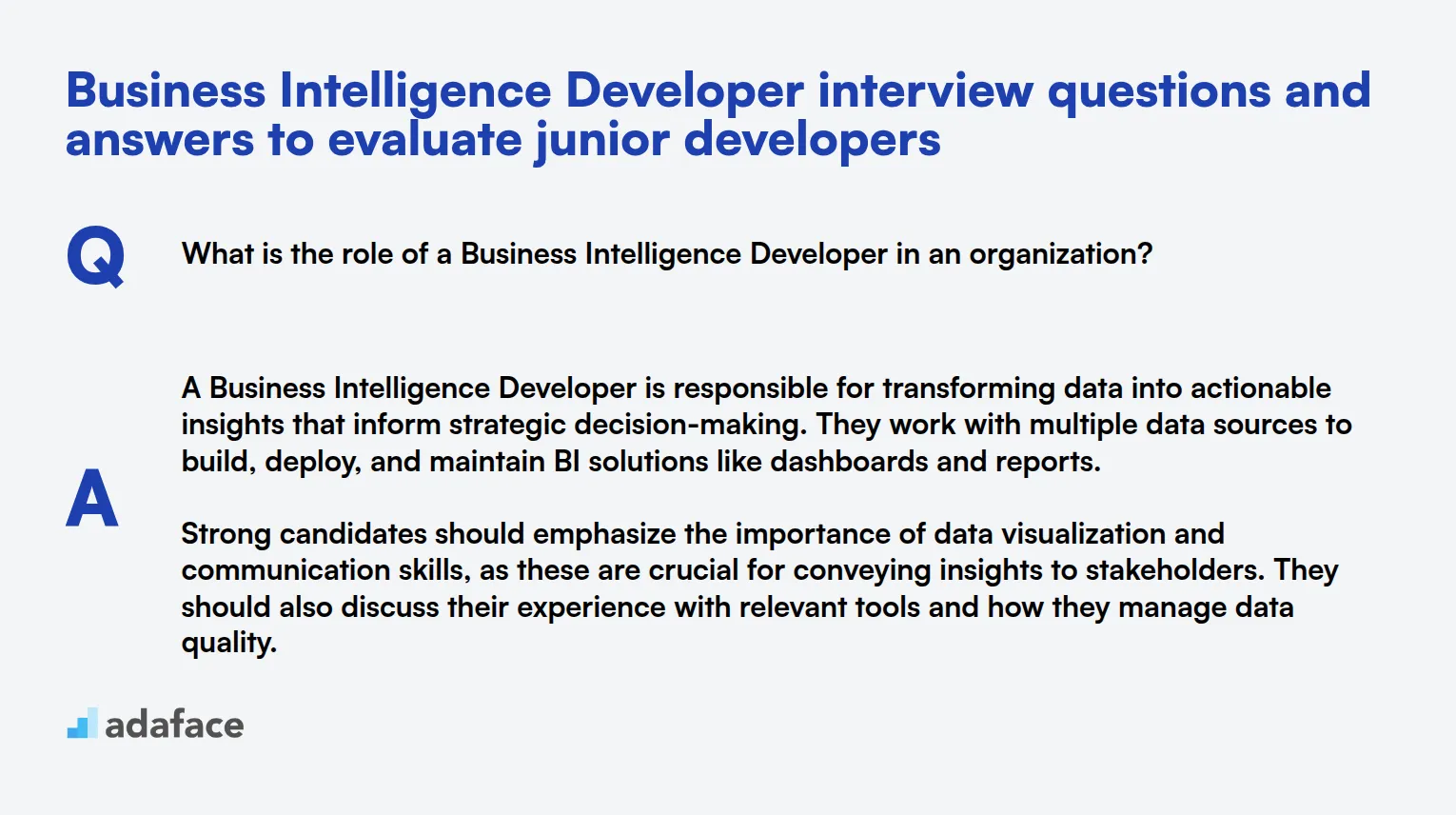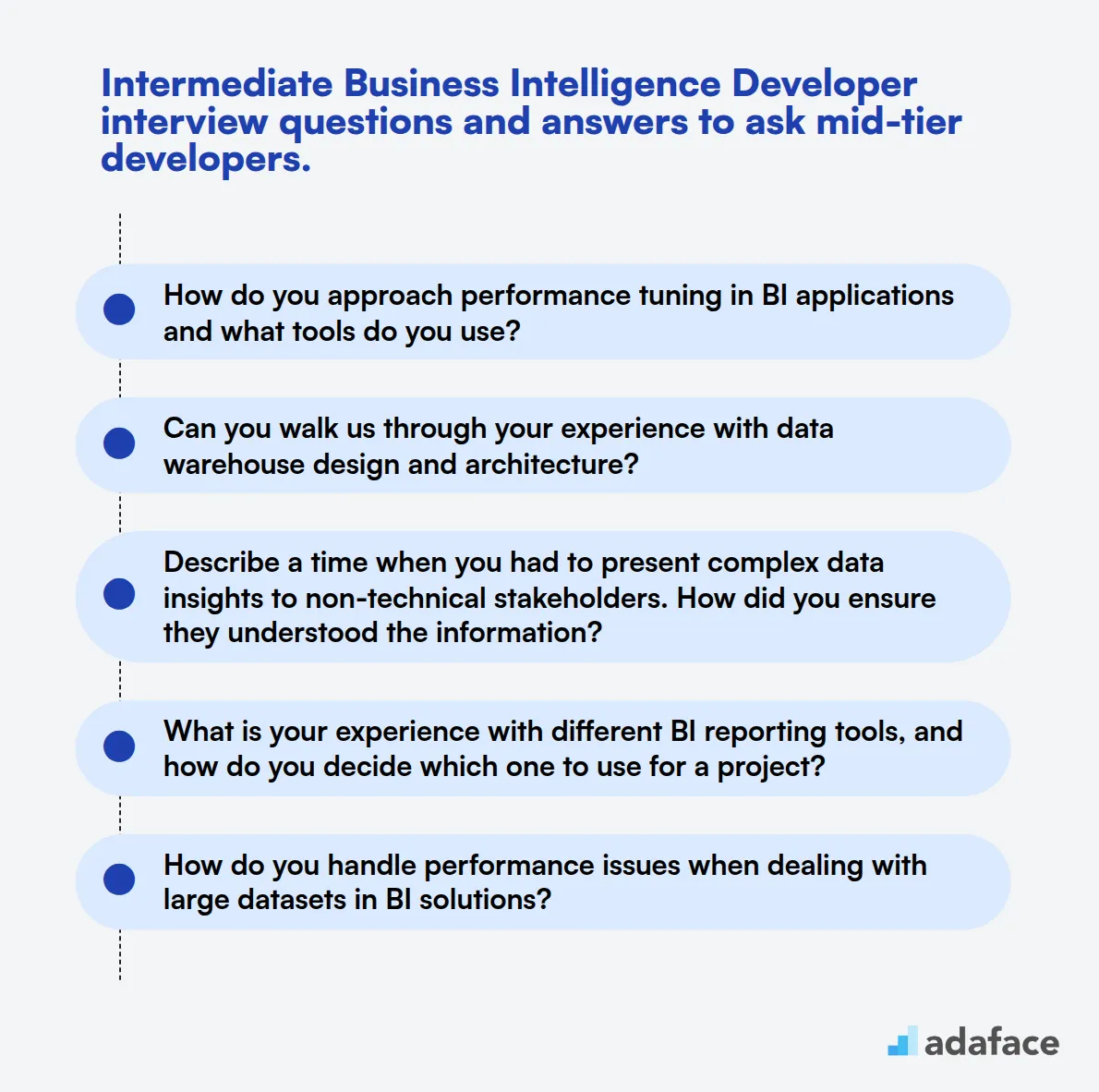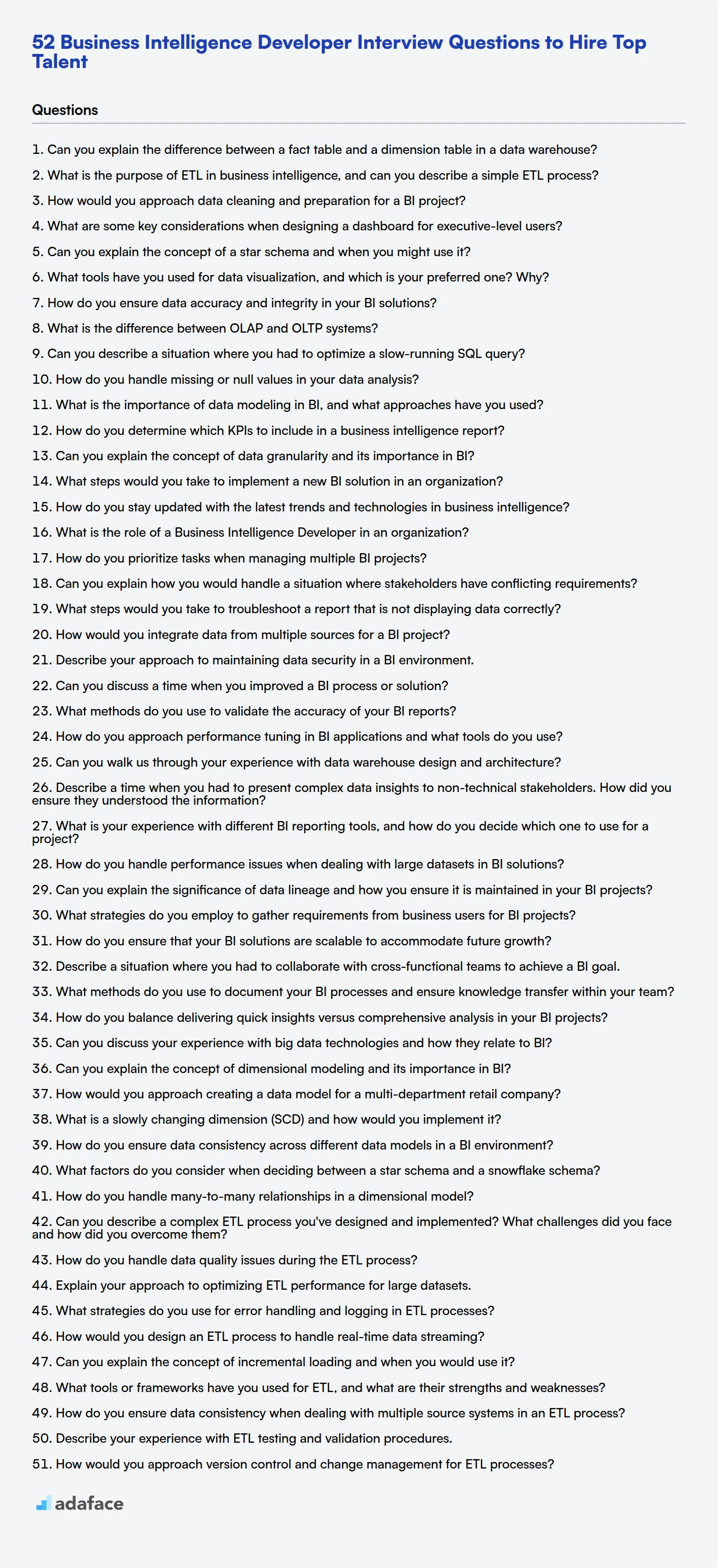In today's fast-paced business world, hiring the right Business Intelligence Developer can make all the difference in transforming raw data into valuable insights. Ensuring your candidates possess the necessary Business Intelligence Developer skills is no small feat during recruitment.
This blog post aims to equip interviewers with a comprehensive list of questions tailored to different levels, from junior to mid-tier developers, focusing on core aspects like data modeling and ETL processes. By skimming through our detailed questions and answers, you'll be prepared to evaluate candidates effectively and make informed hiring decisions.
Using these targeted questions, you can enhance the recruitment process by identifying candidates who align with your business goals. Additionally, consider assessing candidates in advance with our Business Intelligence Developer test to streamline the interview process.
Table of contents
15 basic Business Intelligence Developer interview questions and answers to assess candidates

To effectively assess candidates for Business Intelligence Developer roles, use these fundamental interview questions. They cover essential skills and knowledge, helping you identify top talent efficiently during the hiring process.
- Can you explain the difference between a fact table and a dimension table in a data warehouse?
- What is the purpose of ETL in business intelligence, and can you describe a simple ETL process?
- How would you approach data cleaning and preparation for a BI project?
- What are some key considerations when designing a dashboard for executive-level users?
- Can you explain the concept of a star schema and when you might use it?
- What tools have you used for data visualization, and which is your preferred one? Why?
- How do you ensure data accuracy and integrity in your BI solutions?
- What is the difference between OLAP and OLTP systems?
- Can you describe a situation where you had to optimize a slow-running SQL query?
- How do you handle missing or null values in your data analysis?
- What is the importance of data modeling in BI, and what approaches have you used?
- How do you determine which KPIs to include in a business intelligence report?
- Can you explain the concept of data granularity and its importance in BI?
- What steps would you take to implement a new BI solution in an organization?
- How do you stay updated with the latest trends and technologies in business intelligence?
8 Business Intelligence Developer interview questions and answers to evaluate junior developers

To assess whether junior candidates possess the foundational skills and understanding required for a Business Intelligence Developer role, consider using these targeted questions. Designed to reveal both technical aptitude and problem-solving abilities, these questions are structured to facilitate insightful discussions during interviews.
1. What is the role of a Business Intelligence Developer in an organization?
A Business Intelligence Developer is responsible for transforming data into actionable insights that inform strategic decision-making. They work with multiple data sources to build, deploy, and maintain BI solutions like dashboards and reports.
Strong candidates should emphasize the importance of data visualization and communication skills, as these are crucial for conveying insights to stakeholders. They should also discuss their experience with relevant tools and how they manage data quality.
2. How do you prioritize tasks when managing multiple BI projects?
Prioritizing tasks in BI projects involves assessing the impact and urgency of each task. Developers often use techniques like the Eisenhower Box or agile methodologies to manage their workload effectively.
Candidates should demonstrate their ability to balance short-term demands with long-term project goals. Look for responses that highlight organizational skills and the ability to communicate priorities to team members and stakeholders.
3. Can you explain how you would handle a situation where stakeholders have conflicting requirements?
In situations with conflicting stakeholder requirements, it's important to facilitate open communication and find a common ground. This may involve organizing meetings to understand each party's priorities and constraints.
An ideal candidate will mention the importance of negotiation and compromise. They should highlight experience in stakeholder management and demonstrate how they ensure that all voices are heard and aligned with the organization's objectives.
4. What steps would you take to troubleshoot a report that is not displaying data correctly?
Troubleshooting a report involves checking data sources, verifying filters and calculations, and ensuring there are no connectivity issues. It may also require reviewing any recent changes that could have affected the report.
Candidates should demonstrate a systematic approach to problem-solving and mention any specific tools they use for debugging. Look for answers that show attention to detail and a proactive attitude towards identifying and resolving issues.
5. How would you integrate data from multiple sources for a BI project?
Integrating data from multiple sources involves using ETL processes to extract, transform, and load data into a central repository like a data warehouse. This ensures consistency and accuracy in the data used for BI applications.
Strong candidates should discuss their experience with ETL tools and methodologies. Look for responses that highlight their ability to ensure data quality and address any challenges associated with data integration.
6. Describe your approach to maintaining data security in a BI environment.
Maintaining data security in a BI environment involves setting up access controls, encrypting sensitive data, and regularly auditing data usage and access patterns. It's essential to stay compliant with relevant regulations and standards.
The ideal candidate will emphasize their knowledge of security best practices and experience with implementing security measures. They should also demonstrate an understanding of the balance between accessibility and data protection.
7. Can you discuss a time when you improved a BI process or solution?
Improving a BI process might involve optimizing data queries for faster performance, enhancing a dashboard's usability, or automating a manual reporting process. This results in more efficient operations and better decision-making.
Look for candidates who can provide specific examples of improvements they've made. They should highlight the impact of their work and discuss any metrics or feedback that demonstrate the success of their initiatives.
8. What methods do you use to validate the accuracy of your BI reports?
Validating BI reports involves cross-checking data with source systems, confirming calculations and logic, and seeking feedback from end-users to ensure reports meet their needs. Peer reviews and automated tests can also play a role.
Candidates should describe a systematic approach to validation and discuss any tools they use to support this process. Look for responses that show attention to detail and a commitment to delivering high-quality insights.
12 intermediate Business Intelligence Developer interview questions and answers to ask mid-tier developers.

To evaluate whether your candidates possess the necessary skills for mid-tier Business Intelligence roles, use this list of targeted questions. These inquiries will help uncover their technical expertise and problem-solving abilities, ensuring they align with your organization's needs. For more insights on the role, check out our Business Intelligence Developer job description.
- How do you approach performance tuning in BI applications and what tools do you use?
- Can you walk us through your experience with data warehouse design and architecture?
- Describe a time when you had to present complex data insights to non-technical stakeholders. How did you ensure they understood the information?
- What is your experience with different BI reporting tools, and how do you decide which one to use for a project?
- How do you handle performance issues when dealing with large datasets in BI solutions?
- Can you explain the significance of data lineage and how you ensure it is maintained in your BI projects?
- What strategies do you employ to gather requirements from business users for BI projects?
- How do you ensure that your BI solutions are scalable to accommodate future growth?
- Describe a situation where you had to collaborate with cross-functional teams to achieve a BI goal.
- What methods do you use to document your BI processes and ensure knowledge transfer within your team?
- How do you balance delivering quick insights versus comprehensive analysis in your BI projects?
- Can you discuss your experience with big data technologies and how they relate to BI?
7 Business Intelligence Developer interview questions and answers related to data modeling

When interviewing for a Business Intelligence Developer role, it's crucial to assess candidates' data modeling skills. These questions will help you gauge their understanding of key concepts and their ability to apply them in real-world scenarios. Use this list to evaluate candidates effectively and find the right fit for your team.
1. Can you explain the concept of dimensional modeling and its importance in BI?
Dimensional modeling is a data structure technique optimized for data warehouse and BI systems. It involves organizing data into facts (measurable events) and dimensions (context for those events). This model aims to improve query performance and make data more intuitive for business users.
Key aspects of dimensional modeling include:
- Fact tables: Contain quantitative data about business events
- Dimension tables: Provide descriptive attributes about the data in fact tables
- Star schema: A simple structure with one fact table surrounded by dimension tables
- Snowflake schema: An extension of the star schema with normalized dimension tables
Look for candidates who can explain how dimensional modeling enhances data analysis, improves query speed, and facilitates easier report creation. Strong answers will also touch on the trade-offs between normalized and denormalized models in BI contexts.
2. How would you approach creating a data model for a multi-department retail company?
When creating a data model for a multi-department retail company, I would follow these steps:
- Identify key business processes (e.g., sales, inventory, customer management)
- Determine facts (e.g., sales amount, quantity sold) and dimensions (e.g., product, store, time)
- Create a high-level star schema for each business process
- Define granularity for fact tables (e.g., individual transaction level)
- Design dimension tables with appropriate attributes
- Consider slowly changing dimensions (e.g., product categories that may change over time)
- Implement conformed dimensions for consistency across departments
An ideal candidate should emphasize the importance of collaborating with stakeholders from different departments to ensure the model meets diverse reporting needs. They should also mention considering future scalability and potential integration with external data sources.
3. What is a slowly changing dimension (SCD) and how would you implement it?
A slowly changing dimension (SCD) is a dimension that changes gradually over time, rather than changing on a time-based schedule. In data warehousing, SCDs are used to track historical changes in dimension attributes.
There are several types of SCDs, with the most common being:
- Type 1: Overwrite the old value with the new value
- Type 2: Add a new row with the changed data and a new surrogate key
- Type 3: Add a new attribute to preserve the old value alongside the current value
To implement an SCD, I would:
- Identify which attributes need historical tracking
- Choose the appropriate SCD type based on business requirements
- Modify the dimension table structure if necessary (e.g., adding effective date and end date for Type 2)
- Update ETL processes to handle the chosen SCD type
Look for candidates who can explain the trade-offs between different SCD types and provide examples of when each type might be appropriate. Strong answers will also touch on the impact of SCDs on storage requirements and query performance.
4. How do you ensure data consistency across different data models in a BI environment?
Ensuring data consistency across different data models in a BI environment is crucial for accurate reporting and analysis. Here are some key strategies:
- Implement a centralized data dictionary or metadata repository
- Use conformed dimensions across different data marts or subject areas
- Establish naming conventions and stick to them consistently
- Implement data quality checks and validation rules in ETL processes
- Use master data management (MDM) techniques for key entities
- Regularly audit and reconcile data across different models
- Implement data governance policies and procedures
A strong candidate should emphasize the importance of collaboration between BI developers, data architects, and business stakeholders to maintain consistency. They might also mention tools or techniques they've used to automate consistency checks or to visualize data lineage across models.
5. What factors do you consider when deciding between a star schema and a snowflake schema?
When deciding between a star schema and a snowflake schema, several factors come into play:
- Query performance: Star schemas generally offer better query performance due to fewer joins.
- Data integrity: Snowflake schemas can enforce better data integrity through normalization.
- Storage efficiency: Snowflake schemas may use less storage due to reduced data redundancy.
- Ease of understanding: Star schemas are often easier for business users to understand.
- Maintenance complexity: Snowflake schemas can be more complex to maintain and update.
- Flexibility for changes: Snowflake schemas might be more flexible for certain types of dimension changes.
- ETL process complexity: Star schemas often have simpler ETL processes.
An ideal candidate should be able to weigh these factors based on specific project requirements. They should also mention that hybrid approaches are sometimes used, where some dimensions are snowflaked while others remain denormalized. Look for answers that demonstrate an understanding of real-world trade-offs and the ability to make design decisions based on business needs rather than purely theoretical considerations.
6. How do you handle many-to-many relationships in a dimensional model?
Handling many-to-many relationships in a dimensional model typically involves creating a bridge table or a factless fact table. Here's how I would approach it:
- Identify the many-to-many relationship between dimensions
- Create a bridge table that contains the keys from both dimensions
- If applicable, add any attributes specific to the relationship
- Consider adding a weighting factor if needed for accurate aggregations
- Ensure the granularity of the bridge table matches the relationship
- Update ETL processes to populate and maintain the bridge table
- Modify queries to use the bridge table when joining the related dimensions
A strong candidate should be able to provide examples of when they've used this approach, such as handling product bundles or customer-account relationships in banking. They might also discuss alternative approaches like outrigger dimensions or junk dimensions for simpler cases. Look for answers that demonstrate an understanding of the impact on query performance and the ability to balance model complexity with analytical requirements.
10 Business Intelligence Developer questions related to ETL processes

To assess a candidate's proficiency in ETL processes, essential for any Business Intelligence Developer role, consider using these 10 interview questions. These questions will help you gauge the applicant's practical knowledge and problem-solving skills in data extraction, transformation, and loading scenarios.
- Can you describe a complex ETL process you've designed and implemented? What challenges did you face and how did you overcome them?
- How do you handle data quality issues during the ETL process?
- Explain your approach to optimizing ETL performance for large datasets.
- What strategies do you use for error handling and logging in ETL processes?
- How would you design an ETL process to handle real-time data streaming?
- Can you explain the concept of incremental loading and when you would use it?
- What tools or frameworks have you used for ETL, and what are their strengths and weaknesses?
- How do you ensure data consistency when dealing with multiple source systems in an ETL process?
- Describe your experience with ETL testing and validation procedures.
- How would you approach version control and change management for ETL processes?
Which Business Intelligence Developer skills should you evaluate during the interview phase?
While it's impossible to assess every aspect of a candidate's abilities in a single interview, focusing on core Business Intelligence Developer skills is crucial. These key competencies form the foundation for success in the role.

SQL
SQL is a fundamental skill for Business Intelligence Developers. It allows them to efficiently query and manipulate large datasets, which is essential for data analysis and reporting.
To evaluate SQL proficiency, consider using an assessment test with relevant multiple-choice questions. This can help filter candidates based on their SQL knowledge.
During the interview, you can ask targeted questions to gauge the candidate's SQL expertise. Here's an example:
Can you explain the difference between INNER JOIN and LEFT JOIN in SQL, and provide a scenario where you would use each?
Look for answers that demonstrate a clear understanding of join types and their practical applications in data analysis. Strong candidates will provide specific examples of when to use each join type.
Data Modeling
Data modeling skills are vital for Business Intelligence Developers. They need to understand how to structure data efficiently for analysis and reporting purposes.
Consider using a data modeling test to assess candidates' knowledge in this area. This can help you identify those with strong data modeling skills.
To further evaluate data modeling skills during the interview, you can ask a question like:
Describe a situation where you had to design a star schema. What factors did you consider, and how did it improve query performance?
Look for answers that show experience in dimensional modeling, understanding of fact and dimension tables, and awareness of performance optimization techniques.
Data Visualization
Data visualization is key for presenting insights effectively. Business Intelligence Developers should be able to create clear, informative visualizations that communicate data stories.
While there isn't a specific test for this in our library, you can assess this skill through portfolio reviews and practical exercises.
During the interview, you can ask a question to evaluate the candidate's approach to data visualization:
Describe a complex dataset you've worked with and how you chose to visualize it. What tools did you use, and why?
Look for answers that demonstrate understanding of different chart types, ability to match visualizations to data types, and knowledge of popular BI tools like Tableau or Power BI.
3 Effective Tips for Using Business Intelligence Developer Interview Questions
Before you put into practice what you've learned, here are some tips to enhance your interviewing process.
1. Utilize Skills Tests for Pre-Interview Assessment
Incorporating skills tests before interviews can significantly improve the quality of your candidate pool. By assessing relevant skills early on, you can identify which candidates have the necessary expertise for the role.
For Business Intelligence Developers, consider using tests such as the Business Intelligence Developer Test or the SQL Online Test. These assessments will provide you with deeper insights into each candidate's capabilities.
Employing these tests before interviews streamlines the process, allowing you to focus on candidates who truly meet the requirements. This approach not only saves time but also enhances the quality of your final selections.
2. Compile Targeted Interview Questions
It's important to carefully select interview questions, as time during interviews is often limited. Focusing on a concise set of relevant questions will help you evaluate candidates effectively.
In addition to specific Business Intelligence questions, consider including soft skills inquiries that gauge communication and teamwork abilities. Questions related to data analysis or ETL processes can be complemented with inquiries about the candidate's experience with tools like Tableau or Power BI.
Having a well-rounded list that covers essential technical skills and interpersonal effectiveness will maximize your chances of finding the right fit for your team.
3. Incorporate Follow-Up Questions
Simply relying on initial interview questions may not yield a complete understanding of a candidate's expertise. Follow-up questions are essential to uncover deeper insights about their experience and problem-solving abilities.
For example, if a candidate discusses their experience with data modeling, a pertinent follow-up question might be, 'Can you describe a challenging data modeling problem you've encountered and how you resolved it?' This will allow you to gauge their depth of understanding and practical application.
Evaluate Business Intelligence Developer skills with targeted questions and tests
When hiring a Business Intelligence Developer, it's important to accurately assess their skills. The most effective way to do this is by using skill tests. Consider using our Business Intelligence Developer Test to evaluate candidates' proficiency in key areas.
After using the test to shortlist top applicants, you can proceed with interviews. To streamline your hiring process and find the best talent, explore our online assessment platform for more tools and resources.
BI Developer Test
Download Business Intelligence Developer interview questions template in multiple formats
Business Intelligence Developer Interview Questions FAQs
A BI Developer should have strong SQL skills, data modeling experience, proficiency in ETL processes, familiarity with BI tools, and good problem-solving abilities.
Ask questions about dimensional modeling, star schemas, and their experience with specific data modeling tools. Provide real-world scenarios to assess their approach.
Focus on data extraction methods, transformation techniques, loading strategies, and error handling in ETL processes. Ask about their experience with specific ETL tools.
Present hypothetical BI scenarios and ask candidates to explain their approach. Look for logical thinking, creativity, and the ability to break down complex problems.
Key technical skills include SQL, data warehousing concepts, BI reporting tools, data visualization techniques, and familiarity with cloud platforms for BI.

40 min skill tests.
No trick questions.
Accurate shortlisting.
We make it easy for you to find the best candidates in your pipeline with a 40 min skills test.
Try for freeRelated posts
Free resources




